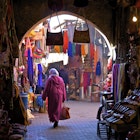
Riding the rails on Africa's first high-speed train between Tangier and Casablanca

Feb 25, 2019 • 7 min read
The sleek Al Boraq, Africa’s first high-speed train, now connects two very different but equally fascinating Moroccan cities – laid-back Tangier, sitting at the crossroads of Europe and Africa, the Mediterranean and the Atlantic, and frenetic Casablanca, the country’s economic hub and architectural treasure trove.
The train, inaugurated by Morocco’s King Mohammed VI and French president Emmanuel Macron in November 2018, runs at speeds of up to 320km/h between the glossy new Tanger Gare and Casa Voyageurs stations, stopping at the industrial city of Kenitra and the capital Rabat, cutting the five-hour journey to around two hours. Now that you can zip between cities, you can pack more into your stay.
Top things to do in Tangier
From 1924 to 1956, when Morocco gained independence from France, Tangier was an International Zone, a bohemian enclave fabled for its hedonistic excesses, with artists, writers and rock stars all falling under its spell. Today, after decades in decline, the city’s story is changing. There’s a new port and luxury marina, hotels are springing up around the Corniche and the medina is getting a facelift.
Start by exploring the Kasbah, the highest and oldest part of the medina and a mix of shady alleys and sun-filled squares. Step through the Bab Al Bahr for views over the Straits of Gibraltar and stop off at the recently renovated Kasbah Museum of Mediterranean Cultures, set in a former sultan’s palace.

Dip down into the medina, past Café Baba on Rue Zaitouni – where a photo of the Rolling Stones’ Keith Richards, marijuana pipe in hand, still has pride of place – to the hubbub of the medina’s main square, the Petit Socco, where the terrace of the Café Tingis on Rue Almohades is perfect for people-watching.
Or follow the ancient walls to the Bab Kasbah, stopping off to shop-til-you-drop at Las Chicas, Tangier’s first concept store, before meandering down Rue de la Kasbah to Place du 9 Avril 1947, otherwise known as the Grand Socco. This teeming square joins the medina to the ville nouvelle (the new city), where the art-deco Cinema Rif has been reinvented as the Cinematheque de Tanger, with an eclectic film programme and a cool cafe.
Nearby, the Grand Hôtel Villa de France has been restored to its former glory. When Matisse painted the view from room 313, there wasn’t the choking traffic, but the Anglican church of St Andrew’s remains unchanged.
At the start of the Corniche and a broad curve of golden sand sits the new Tanja Marina Bay, Morocco’s first urban marina, with space for super-yachts and restaurants such as La Table du Marché and Paul. On a clear day, you can see the whitewashed Spanish town of Tarifa, just 45 minutes away by ferry.

For literature lovers, there’s a room dedicated to Paul Bowles – author of The Sheltering Sky who made the city his home for more than 50 years – at the Tangier American Legation Museum in the medina (itself the USA’s oldest diplomatic property and the only US National Historic Landmark overseas), while William S Burroughs wrote Naked Lunch at the Hotel El Muniria. You can follow in their footsteps on a tour with , stopping off at literary haunts such as the Gran Café de Paris.
Where to eat in Tangier
Tangier has plenty of terraces where you can sip a mint tea. Choose your chai or tuck into authentic Moroccan dishes in ‚Äôs intimate dining spaces or on the sun-filled roof terrace overlooking the Place de la Kasbah on one side and the ocean on the other. Go √Ý la carte or choose from the three-course fixed-price menu, including fresh salads, tajines and almond pastries. Even with a surge of international restaurants, Tangier has stayed true to its Moroccan roots, and the city has a bounty of places to eat like a local.
Where to sleep in Tangier
is a beautifully restored riad in an easy-to-find spot near the Bab Kasbah. Each of the nine rooms is individually decorated, and breakfast – including Moroccan breads and French pastries – is served on the roof terrace along with 360-degree views. The multilingual owner Aziz is extremely knowledgeable about Tangier and its surroundings, and can help with tours to Asilah, Tetouan and Chefchaouen.

Cool things to do in Casablanca
Perhaps most famous for its namesake film – actually shot in a Hollywood studio – Casablanca, dubbed the ‘white city’, is Morocco’s largest metropolis, a blend of traditional and modern with a host of new construction projects under way.
During Morocco’s years as a French Protectorate, French architect and urban planner Henri Prost was invited to develop a city worthy of the country’s economic capital, enlisting the help of Europe’s top architects. Their legacy can still be seen in the city’s wow-factor architecture, a unique mix of neoclassical, art deco, neo-Moorish and modernist. By the 1990s, 20th-century buildings were either falling into elegant disrepair or being razed to the ground to make way for tower blocks, so local architects and artists formed and began campaigning for their preservation, including a bid for Unesco World Heritage status. If you’re not in the city for their annual heritage days (the second week of June in 2019) when they run free architectural tours around four areas of the city, you can arrange a private tour (no charge but donations welcome). In the heart of the art-deco district, the Abderrahman Slaoui Foundation Museum is home to a beautiful collection of Moroccan decorative arts, from vintage travel posters to magnificent Berber jewellery and ornate glassware, alongside temporary exhibitions. The top-floor cafe is a good spot for a sightseeing break.
Locals flock to Place Mohammed V, flanked with imposing buildings including the Moorish-inspired Palais de Justice and the ultra-contemporary Grand Theatre de Casablanca, which will be the largest multipurpose theatre in Africa when it opens later this year. Nearby, the finishing touches are being put on the leafy Parc de la Ligue Arabe and the neighbouring Cathédrale du Sacré Coeur, blindingly white and a striking mix of art-deco, Moorish and neo-Gothic architecture, which will soon reopen as a cultural centre.
The constantly chaotic Place des Nations Unies is the meeting point for the city’s major thoroughfares, home to the futuristic dome designed by French-Moroccan architect Jean-François Zevaco, currently being revamped along with the underpass that will double as an exhibition space. In the northeast corner, the clock tower marks the entrance to the whitewashed 19th-century old medina, ideal for idle wandering – look out for a mosque, church and synagogue sitting side by side.
Hail a petit taxi to the Quartier Habous, the picturesque French-built ‘new medina’ to explore the laid-back souq and the Mahakma du Pasha, a 1950s courthouse built in ornate Moorish style. Stop off for a sweet treat at the legendary Pâtisserie Bennis Habous – perhaps cornes de gazelle (crescent-shaped pastries filled with almond paste and orange-blossom water).


Take the hour-long tour of the stunning Hassan II Mosque, perched on a rocky outcrop overlooking the Atlantic. It’s one of only two mosques in Morocco open to non-Muslims and a showcase for the finest Moroccan crafts, including dazzling colourful geometric zellige tiles, hand-carved wood and acres of marble.
Where to eat in Casablanca
Try a traditional Moroccan breakfast, such as eggs with khlii (Moroccan dried meat) in the pretty garden restaurant of La Sqala, set in an 18th-century bastion behind the medina’s whitewashed ramparts. In the evening, take a sunset stroll along the waterfront Corniche to Le Cabestan, with its French Riviera feel and Mediterranean menu of just-caught seafood.
Where to sleep in Casablanca
A 1930s villa, Hotel Le Doge & Spa has been sensitively restored to its former art-deco splendour with a showstopping spiral staircase and 16 distinctive rooms decked out in bold colours and period furnishings, along with a Moroccan restaurant, rooftop terrace and marble hammam. Tucked down a quiet residential street, it’s within walking distance to the centre’s key sights.
Make it happen: how to get a ticket to ride
Currently the , the Moroccan railways operator, doesn’t accept non-Moroccan credit cards, so you should buy your tickets in advance at the station with cash or through an agency.
https://shop.lonelyplanet.com/products/morocco-travel-guide-12
Explore related stories





 PhotographyA œ„∏€¡˘∫œ≤ º¥ ±ø™Ω± photographer shares secrets for taking that perfect shot
PhotographyA œ„∏€¡˘∫œ≤ º¥ ±ø™Ω± photographer shares secrets for taking that perfect shotDec 2, 2020 ‚Ä¢ 4 min read

 BooksThese books by African authors will transport you from Algeria to Zimbabwe
BooksThese books by African authors will transport you from Algeria to ZimbabweAug 3, 2020 • 14 min read


